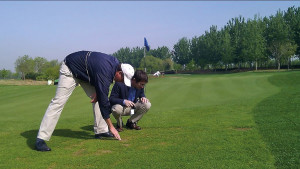Soil nutrient guidelines and turfgrass nutrient requirements

Why is that? Because sand rootzones are relatively low in nutrient-holding capacity. With this in mind, Dr. Larry Stowell from PACE Turf and I have developed the Minimum Level for Sustainable Nutrition (MLSN) guidelines for turfgrass.
This is an approach to managing soil nutrient levels that can help decrease fertilizer inputs and costs, while still maintaining excellent turfgrass performance.
These guidelines are based on a review of data from 6500 turfgrass soils rated average to good by turf managers, along with some relevant research and observations to fine-tune the guidelines specifically for nitrogen, phosphorus, and potassium, the three most important elements applied as fertilizer.

Let's take calcium as an example. The MLSN guideline is 330ppm, meaning that if soil calcium is at 330ppm or more, plenty of calcium will be available to meet the needs of the grass, and no calcium is required as fertilizer. I've already explained how the quantity of calcium in the soil is related to expected plant use - with 330ppm calcium in the soil, that is approximately how much calcium the grass would use in 30 years.
We can think about this another way. Grasses use water from the soil as it comes in through the roots, moves up through the plant, and then is transpired through the leaves during the day as the stomata are open. Let's imagine a hypothetical turfgrass area with transpirational water loss of 1,000mm over the course of one growing season. That is water use by the plant of 1,000L for every square metre of turf, 1,000L of water going into the roots over the course of a growing season.

We have the plant using 2 grams of calcium and 1,000L of water per year. But remember, in the soil solution, we don't have pure H2O - there are minerals such as calcium in the water also. As that water flows to the root, and into the root, all the calcium the plant requires will be supplied by mass flow* if the soil solution maintains an average calcium concentration of just 2ppm.
In one square metre of rootzone, to a depth of 10cm, we may have 150kg of soil, thus giving us 49.5 grams of available calcium when the calcium is at the MLSN guideline of 330ppm. In that same square metre of rootzone, assuming soil water content is 20%, we have 20L of water (or soil solution), and assuming the calcium concentration of the soil solution is 2ppm, which supplies all the calcium the grass requires, then we have 40mg of calcium in solution in that one square metre.
The 330ppm MLSN guideline gives us 49.5 grams of calcium which is 1,237 times more than the 40mg of calcium that is in solution and meeting all the needs of the plant.

Article by Dr. Micah Woods, Chief Scientist at the Asian Turfgrass Center.
*mass flow is the movement of nutrients through the soil to the root in the flow of water caused by plant water absorption (Stanley Barber, Soil Nutrient Bioavailability, 1995)
